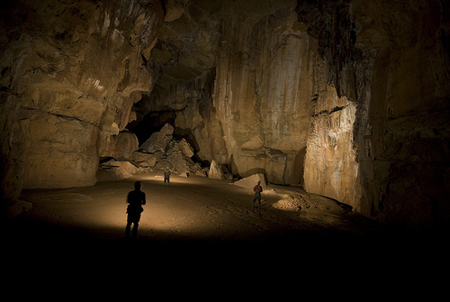A trip to the northeastern states of India is never complete without visiting Meghalaya (where the clouds live) which has some of the wettest parts of the world. Cherapunjee was once ranked highest with some bizzare average of 364 days of rains each year. Theres waterfalls, abundant natural beauty, mountains, clouds, rains, forests … and something which a lot of trip planners leave out – CAVES!
Though international cavers have been active on Indian soil for the past several years, caving as such is a relatively new adventure activity that is attracting greater number of tourists to Meghalaya. Every year, expert cavers from all over the world explore the hills of Meghalaya, to find new caves and map them. Some very large caves with beautiful formations are well mapped and are easily accessible. Caves are located in almost all the districts of the state.
Meghalaya probably has more caving potential than any other state in the country.
These caves, with mainly stalactite and stalagmite formations, are truly nature’s gift and wonder. The deepest and longest of the caves in South Asia are located in Meghalaya. To give you a very brief idea on what caves are all about, Meghalaya has huge deposits of limestone and abundant rainfall (six to eight months in a year), which is the main season for the Karst cave formations. Water dissolves the soluble parts trapped in the limestone and with time the caves get bigger and deeper. The forming of Karst caves is very complicated and it is still a topic of geological research. But some basic aspects are very simple: water containing carbon dioxide is able to dissolve limestone, entering through cracks and, over time, widening it. It may take 100-150 years to form an inch of material to the speleothems. These speleothems may take the form of icicles, trees, statues, or the delicate design of lacy flowers. Caving is a mixture of a lot of activities. It involves a bit of free hand rock climbing, plenty of crawling, going through tight squeezes, walking and, if one is lucky, some swimming. Of course, there are the more technical caves, but they are not for amateur cavers.
Exploration of the more difficult ones would need hundreds of hours of experience and a lot of rope work knowledge, which only experts might possess. For novices, excitement sets in from the word go. Once inside, some people tend to lose their way even when being led by guides. But that is part of the adventure element that goes with caving. When lost, do not panic. It is important not to feel claustrophobic when crawling through narrow crevices. Though dark and mysterious, strangely some of the caves in Meghalaya have large halls, huge pools of crystal clear waters and formations that are absolutely indescribable. One needs to delve deep to actually see the beauty that lies hidden inside the caves.
The longest natural cave in India, Krem Liat Prah is among the 150 already discovered caves in the Shnongrim Ridge of Jaintia Hills. According to the survey, its current length of about 25 kilometers will be increased as nearby caves continue to be linked. Aircraft Hangar- an enormous trunk passage is the main attraction. Many other sites include Synrang-Pamiang, Krem Lubon, in the Sutnga/Sakhain area (near N25°1708′; E92°2731). Krem Chympe, India’s 5th longest cave placed 3 km north of the road passing through the Khaddum village and Sielkan. The river cave has large deep caves in which you would be required to swim. This cave has a bats and possibly cave-adapted fish. This cave has a lot of new things waiting to be discovered. Sielkan Pouk performs as a sink to the cave system.
Krem Lymput, set around 6 km from the village called Nongiri, has a hidden entrance, which has been covered by forests. It is a beautiful cave to explore. The main small entrance hole runs with inclines walls. Move towards a passage, known as “Way to Heaven”. The slippery climb moves to the galleries. These galleries are rich with its calcite formations. Mughal Room is the prime attraction. How apt is that name?
Things to Carry:
• Some amount of cash
• Boots with rubber soles, gloves and kneepads
• Helmet
• Warm clothes with cotton clothing
• Torch or Three sources of light/ waterproof matches
• Boosters and water bottle
• First aid box
Thrillophilia organises some trips into these caves. Check their website for more info





3 comments
i think its amazing!!!!!!!!!!!!!!!!!!!!!!!!!!!!!!!!!!!!!!!!!!!!!!!!!!!!!!!
I like your blog .Totally interesting also extraordinary blog interesting picture gallery
http://book-my-safari.com/
Thank you very much for this write up.
http://pench-national-park-booking.com/